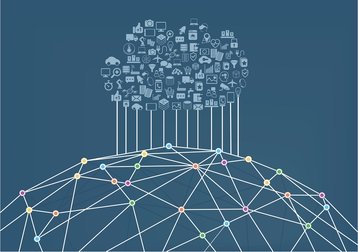The Internet of Things enables a floating city of pleasure... and a vision of hell

Every passenger and all the ship's staff carry a wireless Bluetooth and NFC-enabled medallion about the size of a fat 25-cent coin. Through a massive network of sensors and edge computing devices, the medallion controls the opening of cabin doors, ordering drinks, delivery of services, and in emergencies it ensures no one is missed. Facial recognition is used to identify passengers as they come on board. And their location is known at all times to the ship's captain through a large dashboard that also shows the exact location of each of the ship's workers. This location information is used in many ways -- like by cleaning staff to service a cabin when they notice it is empty. Previously, they had to rely on knocking or other signs of vacancy. It's also used to deliver drinks and food directly to the passenger. And the medallion automatically unlocks the cabin door before the passenger reaches it. Drinks and food are automatically charged to the passenger's account, and alcohol consumption is not monitored or flagged if excessive. The medallion is also used for funds in the ship's casino.
4 reasons why Agile works and the most common excuse when it doesn’t
This is clearly linked to the self-determination because when teams are setting their own deadlines there is automatically an increased level of confidence in the outcome and confidence is a critical component of success. In my experience teams are not afraid of hard work they are afraid of failure. And when you look at the stats around failure, one study showed that on projects that failed, 75% of the time, the teams involved knew it was going to fail on day 1. Now this lack of confidence can become a self-fulfilling prophecy, but by the same thinking, a belief that the project will be successful can also become self-fulfilling. When teams believe a project will fail, when it starts to fail they go into I told you so mode. However when they believe a project will succeed and it starts to fail they go into solution mode. Looking to find out what’s caused the issues and try to resolve them. Teams in solution mode will always outperform teams in I told you so mode.
Cloud computing and regulation: Following the eye of the storm

Out of the rapid growth of cloud computing technologies, we are starting to see a shift in how the law and regulation keep up. A major question mark looming over the sector is its lack of standardized guidance. Cloud computing is not governed by a specific “cloud law,” and no direct regulation applies to its services. Instead, the legal and regulatory landscape is made up of a matrix of different rules, as wide as the scope of the technology itself, spanning multiple industries and geographies. Given this breadth, there has been a gradual shift from legislative solutions to industry standardization as a means of closing the gap between regulation and the eye of the technological innovation storm. Whilst there is no direct legislation, some UK regulators, most notably in the financial services sector, have in recent years published guidance on the use of cloud technologies. This guidance focuses on how the technology can be used in compliance with existing regulatory rules, and whilst it has not set out a step-by-step process for deploying cloud technologies in compliance with regulatory requirements, it has shown that the regulators consider that there is no fundamental reason why firms cannot use cloud services in a regulatory compliant manner.
What is the cloud: beyond infrastructure as a service
Cloud adoption has grown rapidly, and today we find that almost all companies are using some form of cloud. However, research estimates that only approximately 20% of an enterprise's applications are in the cloud today. We are now entering chapter two, where we will focus on getting the next 80% of workloads — the mission-critical ones — to the cloud to optimize everything from supply chains to sales transactions. As we enter this next chapter, the definition of cloud is expanding and companies are now viewing it as an opportunity to incorporate existing IT and private cloud environments with new public cloud capabilities like AI and analytics completely underpinned by security. Moreover, they need to be able to easily choose where to deploy their workloads across all of these environments, which requires a commitment to open source technology and increased automation and management. This is a hybrid cloud approach, and this strategy is helping companies find new ways to solve age-old challenges, launch brand new business services, completely transform user and employee experiences, and much more.
Providing Drivers a Safety Net with Computer Vision

Synthetic Data is fast becoming an essential component of autonomous driving and computer vision AI systems. By bringing together techniques from the movie and gaming industries (simulation, CGI) together with emerging generative neural networks (GANs, VAE’s), we are now able to engineer perfectly-labeled, realistic datasets and simulated environments at scale. There is virtually no incremental cost of additional generated images and since the Synthetic Data is created all the attributes are known to pixel-perfect precision. Key labels such as depth, 3D position and partially obstructed objects are all provided by design. Application of this technology could allow important safety features to be brought to market quickly and cost-effectively, from crash prevention software to predictive maintenance, onboard diagnostics, and location insights. Synthetic Data is a cost-effective solution that cuts down on the time and effort needed to acquire, clean and organize driver data.
Data Uncertainty In The Time Of Brexit: How Business Can Protect Their Data
With so much noise surrounding Brexit and the constant changing circumstances and deadlines, it can be easy for businesses to bury their heads in the sand and wait for the dust to settle. However, it is crucial for businesses to take proactive measures to ensure their data processes stand the test of time. If they don’t act now, they will be left behind by quicker, more agile businesses. Data is the new currency for any business, and not being able to have an easy flow of data from the EU will seriously impact British business. Without the free flow of data to inform customer insights, markets trends, and competitor analysis, the revenue streams of UK businesses will be seriously impacted as delays in data governance, management and usage will put these businesses at a serious competitive disadvantage. With political decisions continuing to fluctuate, organisations need to be prepared. The outcome of good preparation should be the agility that enables organisational resilience in the face of disruption to international data flows.
Phishing attacks that bypass 2-factor authentication are now easier to execute
To overcome 2FA, attackers need to have their phishing websites function as proxies, forwarding requests on victims' behalf to the legitimate websites and delivering back responses in real time. The final goal is not to obtain only usernames and passwords, but active session tokens known as session cookies that the real websites associate with logged-in accounts. These session cookies can be placed inside a browser to access the accounts they're associated with directly without the need to authenticate. This proxy-based technique is not new and has been known for a long time, but setting up such an attack required technical knowledge and involved configuring multiple independent tools such as the NGINX web server to run as reverse-proxy. Then the attacker needed to manually abuse the stolen session cookies before they expire. Furthermore, some websites use technologies like Subresource Integrity (SRI) and Content Security Policy (CSP) to prevent proxying, and some even block automated browsers based on headers.
On the Frontier of an Evolving IT Workscape: What's Ahead for IT Work
People involved in the buying and selling of IT skills are skeptical that the talent pool emerging from four-year universities, business schools and community colleges will provide the skills that enterprises need to prosper. Only 16% of our respondents in large enterprises and 20% of those in midmarket enterprises believe they'll find the necessary skills from these graduates. And only a third of Habitat respondents in large enterprises and half of those in midmarket organizations believe that paying staff well will enable them to acquire the necessary IT expertise. Damien Bean, a former corporate IT vice president at Hilton Hotels Corp. and founder of CareerCurrency LLC, envisions service providers, not educators, playing an expanded role in getting IT work done. "My hypothesis is that the bottom half of the entire portfolio will move to a service model in the next 10 years," he says. "The hidden parts of this equation are demographics and outsourcing. A lot of the newest and most challenging projects are being built partly or solely offshore."
Network monitoring in the hybrid cloud/multi-cloud era

Most newer vendors will have a good API, he adds. Older ones might be slower to open up APIs to customers because they consider the data they produce with their analytics to be proprietary. “Infrastructure teams may have an advantage with some of the legacy tools that they currently have that are expanding into cloud-native environments,” Laliberte says. Tool sets like Riverbed, which integrates SNMP polling, flow and packet capture to get an enterprise network view of performance in hybrid cloud environments, and SolarWinds advanced network monitoring for on-premises, hybrid, and cloud, “give the opportunity to tie in both the legacy and cloud” monitoring, he adds. ... Whether we call it hybrid, cloud or SD networking, the future of networking is software defined – with distributed rather than centralized intelligence or control,” Siegfried says. “The same automation philosophy, infrastructure and code techniques that have disrupted other areas of infrastructure management are applying to networking as well.
Surviving and thriving in year three as a chief data officer
Data and analytics projects can be classified as either defense or offense (in the immortal words of Tom Davenport). Data defense seeks to resolve issues, improve efficiency or mitigate risks. Data quality, security, privacy, governance, compliance – these are all critically important endeavors, but they are often viewed as tactical, not strategic. The only time that data defense is discussed at the C level is when something goes wrong. Data offense expands top line revenue, builds the brand, grows the company and in general puts points on the board. Using data analytics to help marketing and sales is data offense. Companies may acknowledge the importance of defense, but they care passionately about offense and focus on it daily. The challenge for a CDO or CAO is that data defense is hard. A company’s shortcomings in governance, security, privacy, or compliance may be glaringly obvious. In some cases, new regulations like GDPR scream for attention. Data defense has a way of consuming more than its fair share of the attention and staff.
Quote for the day:
"Dont be afraid to stand for what you believe in, even if that means standing alone." -- Unknown

No comments:
Post a Comment